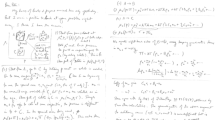Abstract
The biological function of a protein is intimately related to its three-dimensional molecular structure. Although X-ray diffraction from single crystals can be employed to solve for the molecular structure, use of this method is often impeded by the slow rate of precipitation of crystals from the pH buffered, aqueous solutions of strong electrolytes which ordinarily serve as growth media. The rate of crystallization can be measured as a function of growth solution conditions by growing the crystals in a dilatometer. As the crystallization progresses, the rate of change of the system volume caused by the difference in density between the crystals and the solution is reflected in the rate of change of the height of the fluid in the capillary side arm of the dilatometer. In the case of the proteins, lysozyme, and canavalin, this height changes exponentially with time, which serves to define a first-order rate constant or specific crystallization rate, k. A dozen such experiments may be needed to determine how \(k\) depends upon pH, electrolyte concentration, and temperature. Each experiment can require 4 or 5 days to reach equilibrium. If height measurements are made equally spaced in time, however, early time data can be combined according to the Guggenheim procedure, and the value of k can be determined without the experiment having to reach equilibrium. By using this method, the time required to complete an experiment can be reduced by as much as 50 %.




Similar content being viewed by others
References
G.H. Stout, L.H. Jensen, X-ray Structure Determination: A Practical Guide, 2nd edn. (Wiley, New York, 1989)
A.F. McPherson, Crystallization of Biological Macromolecules (Cold Spring Harbor Laboratory Press, New York, 1999)
J.K. Baird, Y.W. Kim, Mol. Phys. 100, 1855 (2002)
Y.W. Kim, D.A. Barlow, K.G. Caraballo, J.K. Baird, Mol. Phys. 10, 2677 (2003)
S.B. Howard, P.J. Twigg, J.K. Baird, E.J. Meehan, J. Cryst. Growth 90, 94 (1988)
E.L. Forsythe, R.A. Judge, M.L. Pusey, J. Chem. Eng. Data 44, 637 (1999)
R.C. DeMattei, R.S. Feigelson, J. Cryst. Growth 110, 34 (1991)
E.L. Forsythe, M.L. Pusey, J. Cryst. Growth 139, 89 (1994)
R.A. Judge, E.L. Forsythe, M.L. Pusey, Cryst. Growth Des. 10, 3164 (2010)
J.K. Baird, J.C. Clunie, Phys. Chem. Liq. 37, 285 (1999)
J.K. Baird, S.C. Hill, J.C. Clunie, J. Cryst. Growth 196, 220 (1999)
K.G. Caraballo, J.K. Baird, J.D. Ng, Cryst. Growth Des. 6, 874 (2006)
J.W. Moore, R.G. Pearson, Kinetics and Mechanism (Wiley, New York, 1981)
K.G. Caraballo, Kinetics of the Crystallization of Canavalin by the Measurement of the Supersaturation Decay, Materials Science M.S. thesis, University of Alabama in Huntsville, Huntsville, AL, 2003
L. Kirkup, Data Analysis with Excel, chap. 6 (Cambridge University Press, Cambridge, 2002)
X. Li, X. Xu, Y. Dan, J. Feng, L. Ge, M. Zhang, Cryst. Res. Technol. 43, 1062 (2008)
N.I. Wakayama, J. Cryst. Growth 191, 199 (1998)
M. Taleb, C. Didierjean, C. Jelsch, J.P. Mangeot, A. Aubry, J. Cryst. Growth 232, 250 (2001)
J.A. Marqusee, J. Ross, J. Chem. Phys. 79, 373 (1983)
M. Ataka, M. Asai, Biophys. J. 58, 807 (1990)
Yu.A. Buyevich, V.V. Mansurov, J. Cryst. Growth 104, 861 (1990)
D.A. Barlow, J.K. Baird, C.-H. Su, J. Cryst. Growth 264, 417 (2004)
D.A. Barlow, J. Cryst. Growth 311, 2480 (2009)
A. Navarro, H.-S. Wu, S.S. Wang, Sep. Purif. Technol. 68, 129 (2009)
M.V. Saikumar, C.E. Glatz, M.A. Larson, J. Cryst. Growth 187, 277 (1998)
J.K. Baird, J. Cryst. Growth 204, 553 (1999)
I.M. Lifshitz, V.V. Slyozov, J. Phys. Chem. Solids 19, 345 (1961)
C. Wagner, Z. Electrochem. 65, 581 (1961)
J.D. Rowe, J.K. Baird, Int. J. Thermophys. 28, 855 (2007)
O. Penrose, J. Stat. Phys. 89, 305 (1997)
G. Madras, B.J. McCoy, Chem. Eng. Sci. 57, 3809 (2002)
C. Noguera, B. Fritz, A. Clement, A. Baronnet, J. Cryst. Growth 297, 180 (2006)
M. Uwaha, K. Koyama, J. Cryst. Growth 312, 1046 (2010)
Author information
Authors and Affiliations
Corresponding author
Rights and permissions
About this article
Cite this article
Baird, J.K., McFeeters, R.L. & Caraballo, K.G. Specific Rate of Protein Crystallization Determined by the Guggenheim Method. Int J Thermophys 35, 830–840 (2014). https://doi.org/10.1007/s10765-012-1377-8
Received:
Accepted:
Published:
Issue Date:
DOI: https://doi.org/10.1007/s10765-012-1377-8




